Filters: Tags: Species distribution model (X)
325 results (65ms)|
Filters
|

The Nature Conservancy (TNC) has derived climate suitability forecasts for most species of trees and shrubs considered to be ecological dominants of terrestrial Californian habitat types. Our plant projections are compiled as decision support tools to help Conservancy project staff, as well as our external partners, develop the necessary plans, priorities and strategies to successfully adapt to uncertain changes in future climate. In the recently completed Southern Sierra Partnership's 2010 Climate-Adapted Conservation Plan for the Southern Sierra Nevada and Tehachapi Mountains, species and habitat forecasts shown here informed the development of a regional conservation design that explicitly incorporates long-term...
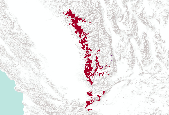
The Nature Conservancy (TNC) has derived climate suitability forecasts for most species of trees and shrubs considered to be ecological dominants of terrestrial Californian habitat types. Our plant projections are compiled as decision support tools to help Conservancy project staff, as well as our external partners, develop the necessary plans, priorities and strategies to successfully adapt to uncertain changes in future climate. In the recently completed Southern Sierra Partnership's 2010 Climate-Adapted Conservation Plan for the Southern Sierra Nevada and Tehachapi Mountains, species and habitat forecasts shown here informed the development of a regional conservation design that explicitly incorporates long-term...

The Nature Conservancy (TNC) has derived climate suitability forecasts for most species of trees and shrubs considered to be ecological dominants of terrestrial Californian habitat types. Our plant projections are compiled as decision support tools to help Conservancy project staff, as well as our external partners, develop the necessary plans, priorities and strategies to successfully adapt to uncertain changes in future climate. In the recently completed Southern Sierra Partnership's 2010 Climate-Adapted Conservation Plan for the Southern Sierra Nevada and Tehachapi Mountains, species and habitat forecasts shown here informed the development of a regional conservation design that explicitly incorporates long-term...

Future (2046-2065) predicted probability of fisher year-round occurrence projected under the A1fi emissions scenario with the Hadley CM3 GCM model (Gordon et al. 2000, Pope et al. 2000). Projected fisher distribution was created with Maxent (Phillips et al. 2006) using fisher detections (N = 102, spanning 1993 – 2011) and seven predictor variables: mean winter (January – March) precipitation, mean summer (July – September) precipitation, mean summer temperature amplitude, mean daily low temperature for the month of the year with the warmest mean daily low temperature, mean fraction of vegetation carbon burned, mean vegetation carbon (g C m2), and modal vegetation class. Predictor variables had a grid cell size of...
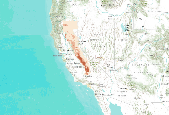
Description: Predicted probability of fisher year-round occurrence created with Maxent (Phillips et al. 2006) using fisher detections (N = 102, spanning 1993 – 2011) and seven predictor variables: mean winter (January – March) precipitation, mean summer (July – September) precipitation, mean summer temperature amplitude, mean daily low temperature for the month of the year with the warmest mean daily low temperature, mean fraction of vegetation carbon burned, mean vegetation carbon (g C m2), and modal vegetation class. Predictor variables had a grid cell size of 10 km, vegetation variables were simulated with MC1 (Hayhoe et al. 2004) and climate variables were provided by the PRISM GROUP (Daly et al. 1994). This...

Predicted probability of marten year-round occurrence derived from future (2076-2095) climate projections and vegetation simulations. Projected marten distribution was created with Maxent (Phillips et al. 2006) using marten detections (N = 102, spanning 1993 – 2011) and eight predictor variables: mean potential evapotranspiration, mean annual precipitation, mean fraction of vegetation carbon burned, mean forest carbon (g C m2), mean fraction of vegetation carbon in forest, understory index (fraction of grass vegetation carbon in forest), average maximum tree LAI, and modal vegetation class. Future climate drivers were generated using statistical downscaling (simple delta method) of general circulation model projections,...

The desert bighorn sheep mountain habitat data provided by  Diane Mastalir (California Department of Fish and Wildlife) is intended to identify historic, current, and potential core habitat for desert bighorn sheep in California (excluding the Peninsular bighorn sheep).This layer represents mountain habitat with a slope of 15% or greater. It was created using a NED 30 meter resolution DEM clipped to the study area. Slope of 15% or greater was extracted from the 30 meter DEM. A conditional evaluation was performed on the image giving the output cell a value of 1.This dataset was resampled from 30m to 270m resolution by Conservation Biology Institute and generalized using majority filter and boundary clean techniques....

The Nature Conservancy (TNC) has derived climate suitability forecasts for most species of trees and shrubs considered to be ecological dominants of terrestrial Californian habitat types. Our plant projections are compiled as decision support tools to help Conservancy project staff, as well as our external partners, develop the necessary plans, priorities and strategies to successfully adapt to uncertain changes in future climate. In the recently completed Southern Sierra Partnership's 2010 Climate-Adapted Conservation Plan for the Southern Sierra Nevada and Tehachapi Mountains, species and habitat forecasts shown here informed the development of a regional conservation design that explicitly incorporates long-term...
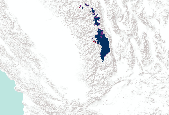
The Nature Conservancy (TNC) has derived climate suitability forecasts for most species of trees and shrubs considered to be ecological dominants of terrestrial Californian habitat types. Our plant projections are compiled as decision support tools to help Conservancy project staff, as well as our external partners, develop the necessary plans, priorities and strategies to successfully adapt to uncertain changes in future climate. In the recently completed Southern Sierra Partnership's 2010 Climate-Adapted Conservation Plan for the Southern Sierra Nevada and Tehachapi Mountains, species and habitat forecasts shown here informed the development of a regional conservation design that explicitly incorporates long-term...
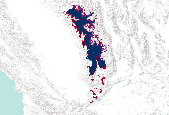
The Nature Conservancy (TNC) has derived climate suitability forecasts for most species of trees and shrubs considered to be ecological dominants of terrestrial Californian habitat types. Our plant projections are compiled as decision support tools to help Conservancy project staff, as well as our external partners, develop the necessary plans, priorities and strategies to successfully adapt to uncertain changes in future climate. In the recently completed Southern Sierra Partnership's 2010 Climate-Adapted Conservation Plan for the Southern Sierra Nevada and Tehachapi Mountains, species and habitat forecasts shown here informed the development of a regional conservation design that explicitly incorporates long-term...

The Nature Conservancy (TNC) has derived climate suitability forecasts for most species of trees and shrubs considered to be ecological dominants of terrestrial Californian habitat types. Our plant projections are compiled as decision support tools to help Conservancy project staff, as well as our external partners, develop the necessary plans, priorities and strategies to successfully adapt to uncertain changes in future climate. In the recently completed Southern Sierra Partnership's 2010 Climate-Adapted Conservation Plan for the Southern Sierra Nevada and Tehachapi Mountains, species and habitat forecasts shown here informed the development of a regional conservation design that explicitly incorporates long-term...

The Nature Conservancy (TNC) has derived climate suitability forecasts for most species of trees and shrubs considered to be ecological dominants of terrestrial Californian habitat types. Our plant projections are compiled as decision support tools to help Conservancy project staff, as well as our external partners, develop the necessary plans, priorities and strategies to successfully adapt to uncertain changes in future climate. In the recently completed Southern Sierra Partnership's 2010 Climate-Adapted Conservation Plan for the Southern Sierra Nevada and Tehachapi Mountains, species and habitat forecasts shown here informed the development of a regional conservation design that explicitly incorporates long-term...

The Nature Conservancy (TNC) has derived climate suitability forecasts for most species of trees and shrubs considered to be ecological dominants of terrestrial Californian habitat types. Our plant projections are compiled as decision support tools to help Conservancy project staff, as well as our external partners, develop the necessary plans, priorities and strategies to successfully adapt to uncertain changes in future climate. In the recently completed Southern Sierra Partnership's 2010 Climate-Adapted Conservation Plan for the Southern Sierra Nevada and Tehachapi Mountains, species and habitat forecasts shown here informed the development of a regional conservation design that explicitly incorporates long-term...
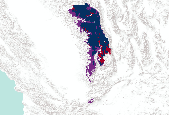
The Nature Conservancy (TNC) has derived climate suitability forecasts for most species of trees and shrubs considered to be ecological dominants of terrestrial Californian habitat types. Our plant projections are compiled as decision support tools to help Conservancy project staff, as well as our external partners, develop the necessary plans, priorities and strategies to successfully adapt to uncertain changes in future climate. In the recently completed Southern Sierra Partnership's 2010 Climate-Adapted Conservation Plan for the Southern Sierra Nevada and Tehachapi Mountains, species and habitat forecasts shown here informed the development of a regional conservation design that explicitly incorporates long-term...
Here we present the map of potential suitable habitat for Mojave menodora (Menodora spinescens var. mohavensis). The data indicate both how many models predicted each location to be potentially suitable for the species and the average standardized habitat suitability score for each location.Data are presented at a spatial resolution of 10 m pixels, which was required to harmonize the original model inputs. However, maps of suitable habitat should be used at a resolution no smaller than 360 m (i.e., 36 pixels x 36 pixels), which corresponds with the resolution of the coarsest model input. These data are intended to be used only to target future plant surveys in areas where new occurrences are most likely to benefit...
Here we present the map of potential suitable habitat for Beaver Dam breadroot (Pediomelum castoreum). The data indicate both how many models predicted each location to be potentially suitable for the species and the average standardized habitat suitability score for each location.Data are presented at a spatial resolution of 10 m pixels, which was required to harmonize the original model inputs. However, maps of suitable habitat should be used at a resolution no smaller than 360 m (i.e., 36 pixels x 36 pixels), which corresponds with the resolution of the coarsest model input. These data are intended to be used only to target future plant surveys in areas where new occurrences are most likely to benefit future...
Here we present the map of potential suitable habitat for Spanish needle onion (Allium shevockii). The data indicate both how many models predicted each location to be potentially suitable for the species and the average standardized habitat suitability score for each location.Data are presented at a spatial resolution of 10 m pixels, which was required to harmonize the original model inputs. However, maps of suitable habitat should be used at a resolution no smaller than 360 m (i.e., 36 pixels x 36 pixels), which corresponds with the resolution of the coarsest model input. These data are intended to be used only to target future plant surveys in areas where new occurrences are most likely to benefit future habitat...
Here we present the map of potential suitable habitat for Ash Meadows gum-plant (Grindelia fraxinipratensis). The data indicate both how many models predicted each location to be potentially suitable for the species and the average standardized habitat suitability score for each location.Data are presented at a spatial resolution of 10 m pixels, which was required to harmonize the original model inputs. However, maps of suitable habitat should be used at a resolution no smaller than 360 m (i.e., 36 pixels x 36 pixels), which corresponds with the resolution of the coarsest model input. These data are intended to be used only to target future plant surveys in areas where new occurrences are most likely to benefit...
Abstract (from http://www.esajournals.org/doi/abs/10.1890/11-2296.1): Physiological tolerance of environmental conditions can influence species-level responses to climate change. Here, we used species-specific thermal tolerances to predict the community responses of ant species to experimental forest-floor warming at the northern and southern boundaries of temperate hardwood forests in eastern North America. We then compared the predictive ability of thermal tolerance vs. correlative species distribution models (SDMs) which are popular forecasting tools for modeling the effects of climate change. Thermal tolerances predicted the responses of 19 ant species to experimental climate warming at the southern site,...
Categories: Publication;
Types: Citation;
Tags: Duke Forest,
Harvard Forest,
Massachusetts,
North Carolina,
Other Wildlife,
This data set provides the abiotic water balance variables used for species distribution modelings for Pinus albicaulis within the Greater Yellowstone Ecosystem
Categories: Data;
Tags: Data Visualization & Tools,
Geospatial dataset,
Idaho,
Montana,
North Central CASC,
|

|